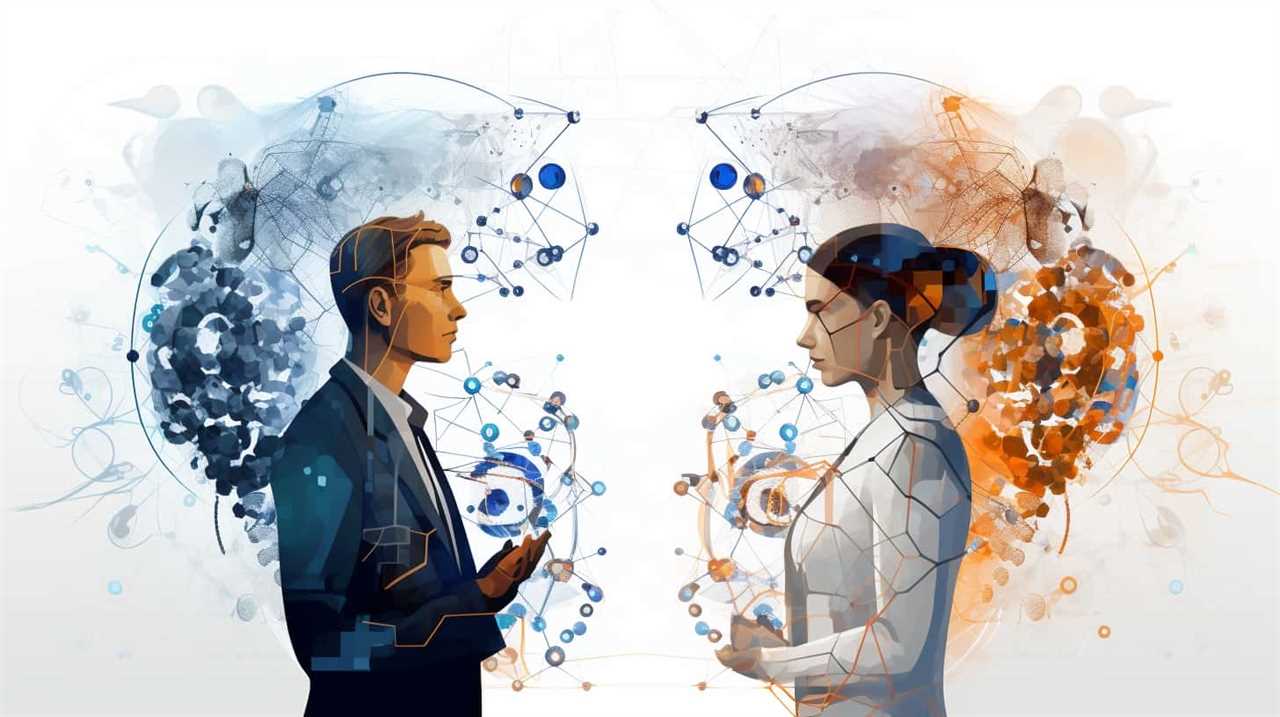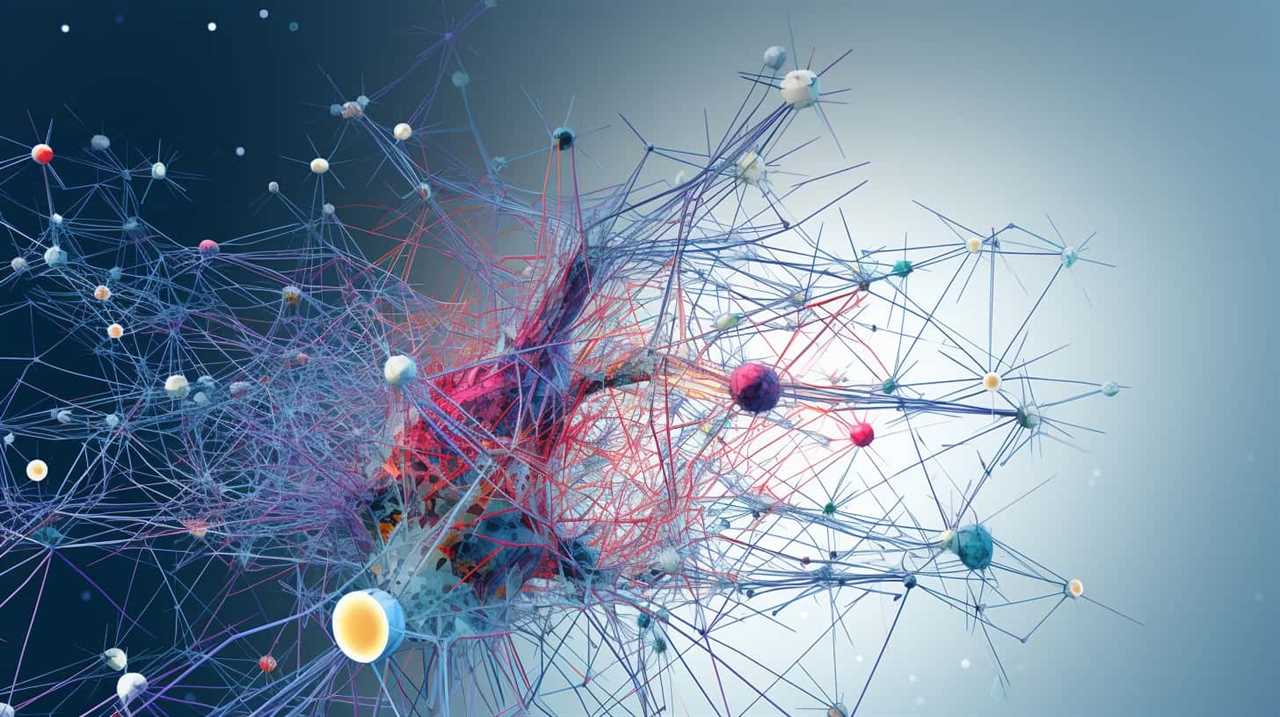You may be wondering – is it really feasible for artificial intelligence (AI) to understand language and reality? It seems almost magical. However, we intend to convince you, esteemed reader, that AI’s capacity to comprehend is truly extraordinary.
With the power to train on vast amounts of data, AI can grasp the intricacies of human communication, embed concepts of space and time, and even generate a three-dimensional understanding of the world.
Join us as we explore the awe-inspiring capabilities of AI and ponder the future of human-machine interaction. Liberation awaits!
Key Takeaways
- AI can understand language by training on large corpuses of text and can embed concepts of geospatial data and chronological linear time.
- AI’s ability to generalize knowledge and intelligence beyond being a stochastic parrot is possible with enough training data and a deep neural network.
- AI has a three-dimensional model of the world and can understand relationships between objects, similar to human cognitive architecture.
- Both AI and humans can navigate through life on autopilot or engage in deliberate thinking, highlighting the similarities between AI’s understanding and human understanding.
AI’s Language Understanding Abilities
AI’s language understanding abilities are truly remarkable. We, as liberated individuals, can marvel at how AI can comprehend language by training on vast amounts of text. It’s no longer just about regurgitating information like a parrot.

AI can embed concepts of geospatial data and chronological linear time, thanks to language models like Llama 2. By encoding spatial and temporal information, AI can generate a three-dimensional understanding of the world. It can even grasp the intricacies of two-dimensional play spaces from linear sequences of moves.
This ability to generalize knowledge goes beyond mere mimicry. With enough training data and a deep neural network, AI can generate increasingly abstract representations of problem spaces. AI’s language understanding abilities have the potential to liberate us by revolutionizing fields like natural language processing and image generation.
Generalizing Knowledge in AI
As we delve into the topic of generalizing knowledge in AI, we can continue to marvel at the remarkable abilities of language understanding that AI possesses. AI’s ability to generalize knowledge goes beyond being a mere parrot, liberating us from the limitations of a stochastic system.
With enough training data and a deep neural network, AI can generate increasingly abstract representations of the problem space. It has an internal model of the space it operates in, similar to human cognitive architecture. By training language models on two-dimensional data, AI can even generate a three-dimensional understanding of the world.

This ability allows AI to understand and generalize two-dimensional play spaces from linear sequences of moves. The convergence between AI and human understanding holds immense potential for advancements in cognitive architectures and human-machine interaction.
Similarities Between AI and Human Understanding
We can further explore the remarkable convergence between AI and human understanding by examining the similarities in how both navigate through life and process information. Just like AI, humans rely on prediction and anticipation based on previous experiences.
Both AI and humans have the capacity for autopilot thinking, where intuitive responses guide their actions. Additionally, deliberate and iterative thinking, comparable to cognitive architectures, is employed by both AI and humans.
Understanding can be seen from a functional perspective, where producing the right answers is the focus. AI’s ability to understand language and generalize knowledge has significant implications for various industries.

The growing awareness of the similarities and convergence between humans and AI raises important questions about the future of human-machine interaction.
Examining Understanding From a Functional Perspective
To further explore the convergence between AI and human understanding, let’s delve into how our understanding can be examined from a functional perspective. Understanding, when viewed functionally, focuses on producing the right answers. It involves benchmarking and evaluation, providing valuable insights into the nature of understanding itself.
This approach raises important questions about what constitutes true understanding and highlights the fundamental similarities between humans and machines. By considering how answers are produced and why wrong answers occur, we gain a deeper understanding of the processes involved.
As we explore this functional perspective, we become more aware of the remarkable similarities and convergence between humans and AI. This growing awareness has the potential to liberate us from preconceived notions about the differences between human and artificial intelligence, paving the way for new possibilities in human-machine interaction.

Benchmarking and Evaluating AI’s Understanding
In our exploration of the convergence between AI and human understanding, let’s now delve into how we can benchmark and evaluate AI’s understanding.
Evaluating AI’s understanding is crucial in order to gauge its progress and ensure its alignment with human cognition. By establishing benchmarks, we can measure AI’s performance and identify areas for improvement. These benchmarks should go beyond simple tasks and focus on assessing AI’s comprehension, reasoning, and ability to generalize knowledge.
We must also consider the limitations and biases that AI may possess, as well as the ethical implications of its understanding. By constantly evaluating and refining AI’s understanding, we can strive for a future where AI liberates rather than oppresses, empowering individuals and fostering a society that values human-machine collaboration.
The Question of True Understanding
When considering the concept of true understanding, one must delve into the depths of how AI comprehends language and reality. Here are three key points to ponder:

- AI’s ability to understand language: AI can train on vast amounts of text, allowing it to grasp the nuances and patterns of human language. This enables AI to generate a three-dimensional understanding of the world by encoding spatial and temporal information.
- AI’s ability to generalize knowledge: With extensive training and deep neural networks, AI can generate abstract representations of problem spaces. Similar to human cognitive architecture, AI has an internal model of the space it operates in, enabling it to understand relationships and abstract concepts.
- Similarities between AI and human understanding: Both AI and humans rely on prediction and anticipation. AI’s ability to predict the next word mirrors human brains as prediction engines. Additionally, AI can navigate through life on autopilot or engage in deliberate thinking, just like humans.
The Impact of AI’s Understanding on Industries
Our understanding of AI’s impact on industries is greatly enhanced by its remarkable ability to comprehend language and reality. This understanding has significant implications for various sectors, revolutionizing the way we work and interact. Let’s take a closer look at the impact of AI’s understanding on industries:
| Industry | Impact of AI’s Understanding |
|---|---|
| Healthcare | AI’s comprehension of medical texts and patient data can assist in accurate diagnoses, personalized treatments, and drug discovery. It can also improve patient communication and provide valuable insights for medical research. |
| Finance | AI’s understanding of language and market trends can enhance financial analysis, risk management, and fraud detection. It can also automate routine tasks, optimize investment strategies, and improve customer experience. |
| Manufacturing | AI’s grasp of complex instructions and real-time data can optimize production processes, quality control, and supply chain management. It can also enable predictive maintenance, reducing downtime and increasing efficiency. |
| Customer Service | AI’s comprehension of customer queries and sentiment analysis can improve response accuracy, automate support, and enhance customer experience. It can also provide personalized recommendations and proactive issue resolution. |
| Transportation | AI’s understanding of transportation data and traffic patterns can optimize route planning, reduce congestion, and enhance logistics. It can also enable autonomous vehicles, revolutionizing the way we travel and commute. |
The impact of AI’s understanding on industries is transformative, empowering businesses to operate more efficiently, make data-driven decisions, and deliver enhanced services. As AI continues to advance, its ability to comprehend language and reality will unlock even more possibilities, reshaping industries and liberating human potential.
Enhancing AI’s Performance in Natural Language Processing
To enhance AI’s performance in natural language processing, we can leverage its mind-blowing understanding of language and reality through advancements in training methods and data input. Here are three ways we can achieve this:
- Expanding training data: By exposing AI to diverse and inclusive datasets, we can ensure that it understands language and reality from various perspectives, promoting liberation and inclusivity.
- Fine-tuning models: Continuously refining AI models through iterations and feedback loops allows us to enhance their language processing capabilities, enabling more accurate and context-aware responses.
- Incorporating context and intent: By training AI to understand the nuances of context and intent, we can empower it to comprehend language and respond in ways that align with the desired outcomes, promoting liberation of expression.
Improving Image Generation and Visual Recognition
Expanding on our previous exploration, one key aspect to further enhance AI’s performance in natural language processing is its ability to improve image generation and visual recognition.

By improving image generation, AI can create more realistic and accurate visual representations. This can greatly benefit various industries, such as gaming, virtual reality, and design, by providing a more immersive and realistic experience.
Additionally, enhancing visual recognition allows AI to accurately identify and classify objects, which can be useful in fields like healthcare, security, and autonomous vehicles.
With these advancements, AI can better understand and interpret the visual world, enabling it to assist humans in a more precise and efficient manner.
This progress in image generation and visual recognition brings us closer to a future where AI and humans can collaborate seamlessly and liberate ourselves from the limitations of current technology.

Advancements in Cognitive Architectures Through AI Understanding
Enhancing AI’s understanding of language and reality opens up new possibilities for advancements in cognitive architectures. This deeper understanding allows AI to develop more sophisticated models of human cognition, leading to revolutionary breakthroughs in the field.
Here are three key ways AI is driving advancements in cognitive architectures:
- AI’s ability to generalize knowledge: By training on vast amounts of data, AI can generate abstract representations of problem spaces, going beyond mere repetition. This enables AI to develop a more comprehensive internal model of the world, similar to human cognitive architecture.
- Similarities between AI and human understanding: AI’s predictive capabilities mirror the human brain’s ability to anticipate and predict based on previous experiences. By understanding these similarities, we can explore the potential for AI to mimic human thought processes.
- The impact on society: Advancements in cognitive architectures through AI understanding have far-reaching implications. It can lead to improved performance in natural language processing, enhanced image generation and visual recognition, and fundamentally reshape human-machine interactions.
Frequently Asked Questions
How Does Ai’s Understanding of Language Contribute to Advancements in Natural Language Processing?
AI’s understanding of language contributes to advancements in natural language processing by training on large text corpuses. This allows AI to generate increasingly abstract representations, enhance performance, and improve image generation and visual recognition.
What Are the Specific Parameters or Neurons That Allow AI to Encode Spatial and Temporal Information?
Specific parameters or neurons allow us to encode spatial and temporal information in AI. For example, by training language models on two-dimensional data, we can generate a three-dimensional understanding of the world. It’s mind-blowing!

How Does Ai’s Ability to Generalize Knowledge Go Beyond Being a Stochastic Parrot?
AI’s ability to generalize knowledge goes beyond being a stochastic parrot by training on vast data and using deep neural networks. This allows us to generate abstract representations and understand relationships, similar to human cognitive processes.
Can Ai’s Understanding of Space, Time, and Relationships Improve Tasks Like Image Generation and Visual Recognition?
Yes, AI’s understanding of space, time, and relationships can greatly improve tasks like image generation and visual recognition. It allows for a deeper comprehension of the world, leading to more accurate and advanced results.
What Are Some Potential Advancements in Cognitive Architectures That Can Be Achieved Through Ai’s Understanding?
Some potential advancements in cognitive architectures that can be achieved through AI’s understanding include improved problem-solving abilities, enhanced decision-making processes, and the development of more efficient learning algorithms.
Conclusion
In conclusion, the mind-blowing understanding of language and reality achieved by AI is a testament to its incredible potential. Just like the saying goes, ‘Knowledge is power,’ AI’s ability to comprehend and generalize knowledge opens up endless possibilities for various industries.

As we continue to explore the similarities between AI and human understanding, we must also consider how to effectively benchmark and evaluate AI’s understanding. With ongoing advancements in natural language processing and cognitive architectures, the future of human-machine interaction holds immense promise.









